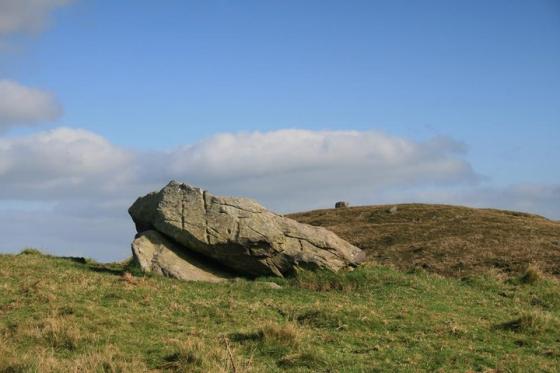



This stone is just 3 paces south of the track and so has suffered the indignity of lots of modern inials being carved into its surface. GPS reading SH 6924 7100.
There are incisions up to 20cm long, 3mm wide and 2mm deep. Lichen on the east side may be hiding more.
The Gwynedd Archaeological Trust list the stone as coming from the medieval period but to me it seems to have similar character to the Llanfairfechan Arrow Stones just across the county boundary in Conwy which are classified as prehistoric.
The supposition already advanced, that they were merely whetstones, is again confirmed by local tradition; and what corroborates this, while it defines the weapons sharpened thereon, is the name given to one of these stones which lies half a mile from Llynanafon, on the side of the path which leads to the lake from the village of Aber, viz. Carreg Saethau (the stone of arrows). The dimensions of the grooves do certainly agree with the size of an arrow-head, and the lengths of the lines agree with the convenient play of a man’s hand whilst rubbing such an instrument backwards and forwards. The grooves vary in length from an inch to eight inches, and their breadth is not in any case much above a quarter of an inch; the greatest depth is likewise rather less than half an inch. There are also a great number of short incisions, which would be required to give a nice finish to the point of such an instrument.
[..] I may remark that, in all cases where these incised stones are found, there are other stones in the immediate neighbourhood, to all appearance equal to them for the purpose of sharpening tools; and in two cases there are excellent hones close at hand. Consequently it becomes a question of some importance why these particular stones were selected in preference to their less honoured neighbours. If we suppose that they were consecrated by authority, whether civil or ecclesiastical, this difficulty is done away with, as the stones would thus become objects of a particular value. Without some such supposition this partiality is not easily accounted for.
I may add that the majority of these stones already discovered are split into two fragments; and the scars are all upon the larger portion, arranged in three distinct groups, with a few isolated marks; but as there are exceptions to these peculiarities, no conclusion can be drawn therefrom. With the above exception, these favoured stones do not apparently differ in any way from others which surround them.
Between the marks on Carreg Saethau are various alphabetical letters crowded together, and cut across each other; to all appearance the initials of persons. A few of them appear fresh; but the greater number seem to be of respectable antiquity.
From ‘The Incised Stones of Caernarvonshire’ by E Owen, in Archaeologia Cambrensis (1864).
“Cerrig Saethau (Arrow Stones) near Llanfairfechan” by W. Bezant Lowe in Proceedings of the Llandudno and District Field Club Vol. VII 1912-13 pp. 61-65 gives the following description:
“The stone measures roughly 4 feet by 5 feet, but it is broken into two pieces. The surface is flat, and the stone is rounded at the edges. The grooves, which vary from 3 inches to 10 inches in length, correspond with the size of an arrow head, the width varying from 3/16 inch to 1/4 inch, and the depth being 3/8 inch. The markings occur in groups.”
Some good photos
















































































































































































